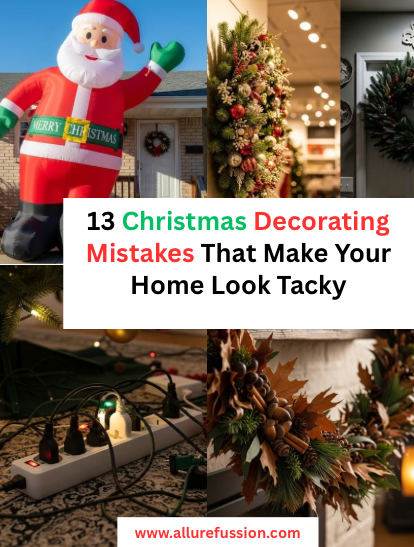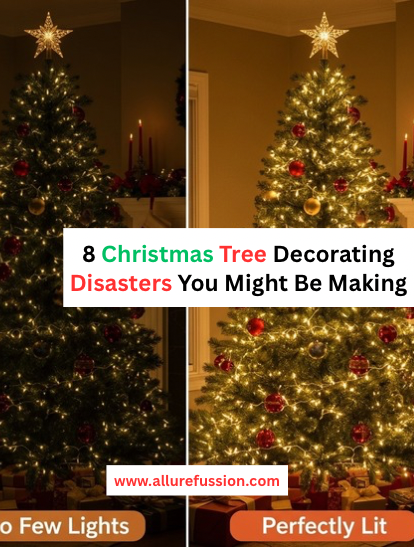I’ll never forget the moment I saw my holiday decorations through fresh eyes. My sister-in-law, who has impeccable taste, walked into my living room and her smile froze for just a second, that polite look people get when they’re trying not to react. That’s when I really looked around and realized my Christmas setup was a chaotic disaster. Mismatched colors everywhere, inflatable Santa fighting for attention with elegant gold ornaments, and enough twinkle lights to cause a small power outage.
That embarrassing moment launched my fifteen-year journey into understanding what actually makes holiday decorating work. I’ve since helped dozens of friends transform their spaces, spent countless hours studying what separates beautiful holiday homes from cluttered ones, and learned that most decorating mistakes follow predictable patterns.
The good news? Once you know what to avoid, fixing these issues is surprisingly straightforward.
What strikes me most about common decorating mistakes is that they’re rarely about money. I’ve seen expensive decorator items look terrible together, and budget decorations look stunning with the right approach.
The difference comes down to understanding a few key principles about visual harmony, restraint, and intentionality. Most people make the same mistakes year after year simply because nobody’s told them what’s going wrong.
The tricky part about holiday decorating is that we’re emotionally attached to it. That hideous reindeer your kid made in second grade? You can’t throw it away. The ornaments from your grandmother? They’re staying even if they clash with everything else. I get it, I have the same attachment to my ratty felt stocking from 1985. The challenge is incorporating sentimental pieces without letting them drag down your entire aesthetic.
Understanding Why Some Christmas Setups Work and Others Don’t
Before we get into specific mistakes, let’s talk about the foundation of good holiday decorating. Three principles separate homes that look festive and pulled-together from ones that look like a craft store exploded: cohesion, scale, and editing.
Cohesion means your decorations relate to each other somehow, through color, style, or theme. You don’t need everything to match perfectly, but there should be a connecting thread. Scale refers to proportion, tiny ornaments on a massive tree, huge decorations in a small room, or decorations that don’t relate to the size of your furniture. Editing is the hardest skill to master because it means leaving things out, even when you love them.
Most tacky decorating happens because people skip these principles. They buy things they like individually without considering how those things work together. They decorate because they feel like they should, adding more and more until every surface is covered. They never step back to assess the overall effect, only focusing on each individual element.
I learned this the hard way. For years, I thought more decorations meant more festive. My mantel had seventeen different items competing for attention. My tree had every ornament I’d ever owned, creating a visual mess that made your eyes tired just looking at it. My color scheme was “all of them.” No wonder my sister-in-law couldn’t hide her reaction.
Decorating Mistakes that make your home look worrisome
1. Using Every Color in the Christmas Rainbow

This is the number one mistake I see, and it’s the one I made for years. Red, green, gold, silver, blue, purple, pink, orange, if it came in a Christmas version, I bought it. The result looked like a tornado hit a holiday store. Your eye didn’t know where to land, and instead of feeling festive, the space felt chaotic.
Here’s what works better: pick two or three colors maximum and stick to them ruthlessly. Traditional red and green with gold accents. Icy blue, silver, and white. Deep burgundy, cream, and copper. Even non-traditional combinations like blush pink and gold or navy and silver work beautifully because they’re consistent. Once you’ve chosen your palette, everything else becomes easy, you simply don’t buy decorations that don’t fit.
I switched to a blue, silver, and white scheme five years ago, and the transformation was immediate. Suddenly my decorations looked intentional instead of random. People started complimenting my “style” even though I was using many of the same ornaments, I’d just removed everything that didn’t fit the color story.
2. Covering Every Single Surface with Decorations

Empty space isn’t your enemy, it’s what makes your decorations visible. I used to think every shelf, table, counter, and horizontal surface needed something festive on it. The result was visual exhaustion. Your brain couldn’t process all the information, so nothing stood out as special.
Professional decorators use something called negative space, areas without decoration that give your eye a place to rest. A beautifully decorated mantel loses its impact if the coffee table three feet away is also packed with decorations competing for attention. Your stunning tree becomes background noise if every wall has wreaths and every shelf has figurines.
Try this experiment: remove half your decorations and see how the space feels. I bet it feels better. The remaining decorations suddenly get the attention they deserve. You can actually see and appreciate each piece instead of registering a general blur of “Christmas stuff.”
3. Mixing Too Many Decorating Styles
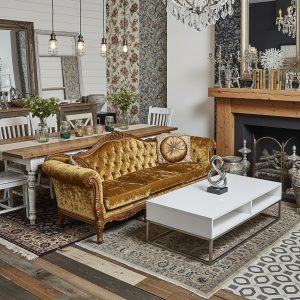
Rustic farmhouse mixed with glam metallics mixed with traditional Victorian mixed with modern minimalist doesn’t create an eclectic look, it creates confusion. Each style has its own visual language, and combining too many languages creates gibberish.
I see this most often with trees. Someone has collected ornaments over years from different periods of their life, each in a different style. Handmade felt ornaments next to sleek glass balls next to cartoon character ornaments next to elegant beaded pieces. Individually, each might be lovely. Together, they fight each other.
You don’t need to throw away ornaments that don’t match your current style. Rotate them, use different ornaments in different years, or put sentimental pieces that don’t match your aesthetic in bedrooms or less visible areas. Your main display spaces should have stylistic consistency. If you’re going rustic, commit to rustic. If you’re doing elegant and formal, don’t throw in cute country pieces that break the mood.
4. Neglecting Proper Lighting
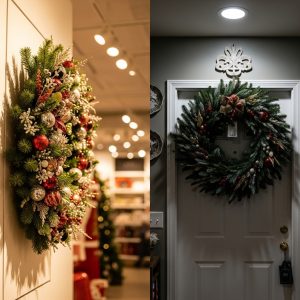
Decorations that look great in store lighting often disappoint at home because you haven’t considered how they’ll be lit. That gorgeous wreath looks sad and flat in a dim entryway. Your beautiful tablescape gets lost in harsh overhead lighting. The ornaments you loved at the store look dull on your tree because there aren’t enough lights.
Proper lighting requires layering, ambient light from overhead fixtures, accent lighting highlighting specific decorations, and the glow from candles or string lights creating atmosphere. Most people under-light their Christmas decorations. A good rule: you need about 100 lights per foot of tree height. A six-foot tree needs 600 lights minimum, and most people use maybe 200.
Beyond quantity, consider light color temperature. Warm white lights (2700-3000K) create cozy, traditional vibes. Cool white lights (4000-5000K) look modern and crisp. Mixing the two looks like a mistake, not a choice. Pick one temperature and stick with it throughout your space.
5. Choosing Decorations That Don’t Fit Your Space’s Scale

A massive inflatable Santa on a small front porch looks ridiculous. Tiny ornaments on a twelve-foot tree disappear. Huge decorations in a small room make the space feel even smaller. Scale matters more than people realize, and getting it wrong makes everything look off.
I learned this with wreaths. I bought what I thought was a beautiful wreath online, and when it arrived, it was enormous, way too big for my front door. It looked like the wreath was eating the entrance. On a double door or larger space, it would have been perfect. On my standard door, it was comically oversized.
Before buying decorations, measure your spaces. Know the dimensions of your door, your mantel, your table. When shopping, bring a tape measure or use your phone. That gorgeous garland might be too thick for your stair railing. Those candlesticks might be too tall for your dining table if people need to see each other across it. Size appropriately, and your decorations will look balanced and intentional.
6. Leaving Visible Cords and Mechanical Elements Exposed
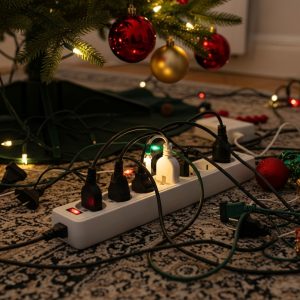
Nothing ruins the magic faster than seeing the power strip under your tree, cords snaking across the floor, or the mechanics of animated decorations visible. These practical elements need to exist, but they shouldn’t be part of your visual presentation.
I spent years ignoring this until I saw a photo of my living room and noticed that the cords were literally the most visible element. White cords on dark floors, extension cords stretched across walkways, power strips in plain sight. It looked sloppy and unfinished.
Hide cords behind furniture or tape them along baseboards in matching colors. Use cord covers if necessary. Place power strips behind curtains or furniture. For outdoor lights, run cords along edges and corners, not straight across walls. If something requires batteries instead of plugs, spend the extra money, it’s worth it for the cleaner look. This attention to finishing details separates amateur decorating from professional-looking spaces.
7. Forgetting About Proportion in Ornament Sizes
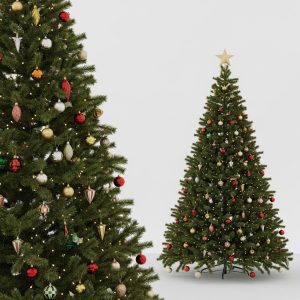
A tree decorated entirely with small ornaments looks sparse and unfinished. One decorated only with large ornaments looks heavy and overwhelming. The magic happens in the mix, but most people don’t think about creating a balanced distribution of sizes.
Professional tree decorators use a ratio system: roughly 40% large ornaments, 30% medium, and 30% small. The large ornaments create visual anchors and fill space. Medium ornaments are your workhorses, filling in gaps. Small ornaments add detail and sparkle without overwhelming. This distribution creates depth and visual interest while maintaining balance.
I started shopping for ornaments by size category rather than just grabbing what I liked, and my tree improved dramatically. I realized I’d been buying mostly medium ornaments because they’re usually the cheapest, and my tree lacked the dramatic impact of large pieces and the delicate detail of small ones. Now I make sure each year’s new ornaments include a mix of sizes to maintain proper proportion.
8. Using Damaged or Worn-Out Decorations
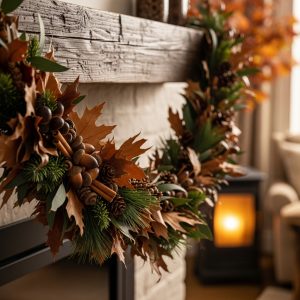
That wreath with half its berries missing, the garland that’s more brown than green, the lights with several bulbs burned out, the ribbon that’s faded and frayed, these need to be replaced, not reused. Damaged decorations make your entire display look neglected and shabby.
I’m guilty of this. I kept using the same outdoor wreath for eight years, and by year eight, it looked pathetic. The bow was weathered and stained, artificial greenery had faded to a weird yellow-green, and the whole thing looked limp. I didn’t see it because the decline was gradual, but photos from that year are embarrassing. The wreath dominated my front entrance, and it looked terrible.
Do an honest assessment of your decorations each year before you put them up. If something is damaged, fix it or replace it. If artificial greenery has faded or lost its shape, it’s done. If ribbons are permanently wrinkled or stained, buy new ones, they’re cheap. If lights have dark sections, replace them. Quality matters, but condition matters more. A few well-maintained pieces beat many worn-out ones every time.
9. Ignoring Your Home’s Existing Style

If your home is modern with clean lines and minimalist furniture, traditional Christmas decorations with lots of frills and patterns will look out of place. If you have a cozy farmhouse aesthetic, ultra-modern metallic decorations will feel wrong. Your Christmas decorations should complement your home’s existing style, not fight against it.
This doesn’t mean you can’t do Christmas if you have a modern home, it means you choose modern Christmas decorations. Geometric ornaments, simple color palettes, clean lines, uncluttered arrangements. Similarly, a traditional home can absolutely do Christmas, but it works best with classic ornaments, richer colors, and more elaborate decorations.
I see people try to transform their homes entirely for Christmas, decorating in a style completely different from their everyday aesthetic. It always looks forced and uncomfortable, like the decorations are visiting rather than belonging. Instead, think of Christmas decorations as accessories for your home’s existing outfit, they should enhance what’s already there, not cover it up.
10. Placing Decorations Without Considering Sightlines

You walk into a room and your eye goes to certain places first, these are your natural focal points, and that’s where your best decorations should go. Instead, people often put their most impressive decorations in corners or areas you don’t naturally look at, while leaving prime visual real estate bare or poorly decorated.
Stand in your main room’s entry point and notice where your eye lands first. That’s where your statement decoration should be. In most living rooms, it’s the fireplace mantel or the main wall. Your tree should go where it’s visible from your main seating area, not tucked in a corner where you have to crane your neck to see it.
I rearranged my living room one year and realized my tree had been in a terrible spot for five years. It was in the corner behind a chair, so you couldn’t see it from the couch or when entering the room. Moving it to where it was actually visible made such an obvious difference that I felt silly for not realizing it sooner. Think about viewing angles and traffic flow, and place your decorations accordingly.
11. Overusing Themed or Character Decorations

A few character ornaments from your kids’ favorite movies? Cute. An entire tree covered in cartoon characters? Tacky, unless it’s specifically a kids’ room tree. Themed decorations, whether characters, sports teams, or hobby-related items, work best as accent pieces, not the entire decorating pieces.
I love my vintage Star Wars ornaments, but when I used them as my main tree theme, the result looked more like a toy collection than holiday decor. Now I use two or three as personal touches mixed into a larger, more traditional scheme. They add personality without overwhelming the aesthetic.
If you love themed decorations, consider having a second smaller tree specifically for them, a kids’ tree in the playroom, a sports tree in a den, a Disney tree in a bedroom. This lets you enjoy your collections without sacrificing the more polished look in your main spaces. Your primary display should appeal to everyone and create that universal holiday feeling, with personal touches woven in carefully rather than dominating.
12. Failing to Edit and Curate Your Collection
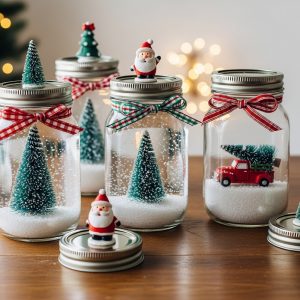
Just because you own something doesn’t mean you must display it every year. I have bins of decorations, but I don’t use all of them annually. Each year, I pull out what works for my current space and color scheme, and I leave the rest stored. This rotation keeps things fresh and prevents overcrowding.
The inability to edit is often emotional. These decorations have memories attached. Your kids made some. Your grandmother gave you others. You bought that expensive piece on vacation. I understand, I have the same attachments. But displaying everything creates visual chaos that actually diminishes each piece’s impact.
Create an “A team” of decorations that work perfectly together and look cohesive. These are what you display in main areas. The sentimental pieces that don’t match go in personal spaces like bedrooms, or you rotate them through different years. Not everything needs to be out simultaneously. By curating intentionally, each decoration gets its moment instead of being lost in a crowd.
13. Decorating Too Early or Leaving Things Up Too Long

This might seem unrelated to aesthetics, but timing affects perception. Decorations that go up right after Halloween look desperate for attention. Decorations still up in late January look forgotten and sad. There’s a sweet spot for Christmas decorating, generally early to mid-December through early January, that feels right and keeps decorations feeling special rather than permanent fixtures.
Beyond social timing, there’s a practical consideration: the longer decorations are up, the more worn they look. Real greenery dries out. Ribbons get dusty. Things shift and sag. What looked fresh and beautiful in early December looks tired by February. I used to leave my decorations up until late January because taking them down felt sad, but I noticed they looked progressively worse as time went on.
Now I decorate the first week of December and take everything down by January 10th. This shorter window means my decorations stay fresh-looking throughout their display period, and honestly, the limited time makes them feel more special. Scarcity creates value, if Christmas decorations are up for four months, they lose their magic.
What You Should do for Better Holiday Decorating
The common thread through all these mistakes is lack of intention. Most tacky decorating happens because people are on autopilot, doing what they’ve always done, buying what catches their eye, adding without subtracting. The solution is bringing conscious decision-making to your decorating process.
Start by taking photos of your current holiday setup. Photos reveal problems you don’t notice in person because you’re too close to it. Look at those photos critically. Do you see any of these thirteen mistakes? Probably several.
That’s okay, now you know what to fix.
Make a plan for addressing the biggest issues first. If your color scheme is all over the place, that’s your priority. Choose your palette and commit to it, even if it means retiring decorations you love but that don’t fit. If you’re overcrowding surfaces, edit ruthlessly. If your lighting is insufficient, invest in more lights before next season.
Shop with intention rather than impulse. Before buying any decoration, ask yourself: Does this fit my color scheme? Does this match my home’s style? Do I have an appropriate place to display it? Is the scale right for my space? If the answer to any question is no, don’t buy it, no matter how cute or cheap it is.
Finally, give yourself permission to evolve. Maybe your decorating style from ten years ago doesn’t work for you now. Maybe your kids are grown and you want something more sophisticated. Maybe you’ve moved to a different size or style of home. It’s okay to change direction, donate decorations that no longer serve you, and start fresh with a new approach.
The goal isn’t perfection, it’s creating a holiday atmosphere that makes you happy and feels cohesive and intentional rather than chaotic. Once you understand these common mistakes, you’ll start seeing them everywhere, and you’ll also start noticing what makes beautiful holiday decorating work. That awareness alone will transform your approach, even if you keep many of the same decorations you’ve always used.
Your home should feel more beautiful and special during the holidays, not more cluttered and stressful. By avoiding these thirteen mistakes, you create space for the magic to happen, literally and figuratively. Sometimes less really is more, and that’s especially true for Christmas decorating.
